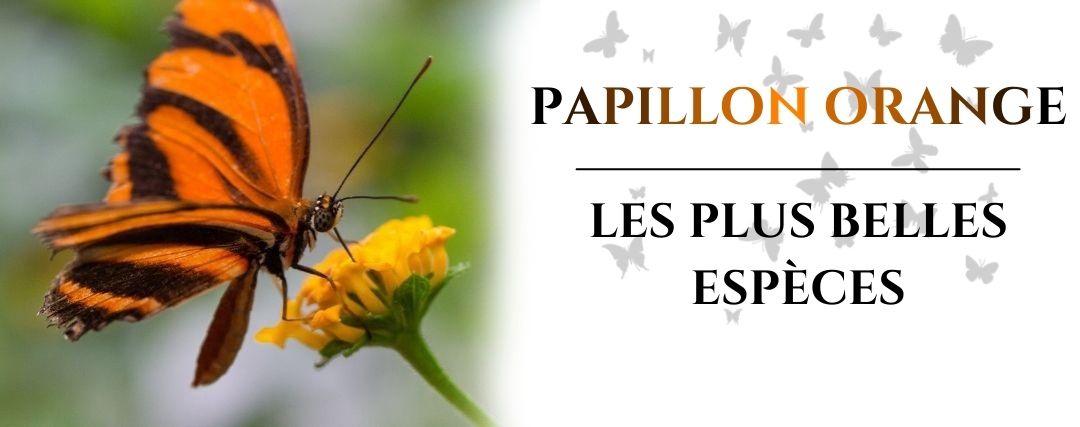Are orange butterflies rare?
Orange butterflies are quite common. The Monarch is the most famous of them. It is particularly visible in North America and is known for its large migration area.
Where can they be found ?
Orange colored butterflies are very common. They are found literally on every continent except Antarctica.
What do orange butterflies symbolize?
Orange butterflies symbolize concentration and passion. Many situations may arise in your life that will distract you from your goals. An orange butterfly enters your life to remind you that you must move towards your goals and never lose focus. They convey important messages that you must take into account to achieve the main goals in your life.
Seeing an orange butterfly also means that a big transformation will take place in the future and that you should not turn away from your main goal during this phase of change.
You should not let your emotions dictate your professional and personal decisions. Think logically and do what is right and necessary.
The most beautiful species of orange butterflies around the world
Limenitis archippus

Limenitis archippus, also called the Viceroy, is a North American butterfly belonging to the Nymphalidae family.
Its wings feature an orange and black pattern, and over most of its range adopts a Müllerian mimetic with the monarch butterfly. The wingspan of the Viceroy is between 53 and 81 mm. It is distinguished from the monarch, which we will see a little further down, by its smaller size and by the postmedian black line which crosses the veins of the hind wing.
It is found throughout most of the contiguous United States as well as parts of Canada and Mexico.
In Florida, Georgia, and the American Southwest, viceroys share the queen motif ( Danaus gilippus ) and in Mexico they share the soldier motif ( Danaus eresimus ). In these three regions, the local Danaus population mimics the coloration of the viceroy species. The viceroy was originally thought to exhibit Batesian mimicry of the other three species, and was thought to be edible or only slightly unpalatable to predators, but this proved false. In an experiment where the wings of the monarch and viceroy were removed, it was discovered that the birds thought the viceroy was just as unpalatable as the monarchs.
Dryadula phaetusa

Dryadula is a monotypic genus of the family Nymphalidae. Its only species, Dryadula phaetusa, is a butterfly with a wingspan varying from 86 to 89 mm.
Its color is a bright orange with thick black bands in males and a duller orange with fuzzier black bands in females.
It resides from Brazil to central Mexico. It is usually found in low-lying tropical fields and valleys.
Vindula arsinoe

Vindula arsinoe is a butterfly of the Nymphalidae family.
This large butterfly exhibits sexual dimorphism : the male's wings are orange with black markings and some black streaks, as well as four small ocelli on the hind wing. The female has a dominant color closer to brown with similar markings. The undersurface of its wings is dull orange with dark brown streaks, the eyespots and other markings are more prominent.
This butterfly can be found in Australia and Malaysia. Its preferred habitat is tropical forests where it can find Passifloraceae.
Danaus plexippus

Danaus plexippus, also called the monarch butterfly or simply monarch, is a famous, vibrantly colored butterfly in the Nymphalidae family. It is perhaps the most familiar North American butterfly and is considered an iconic pollinator species.
Its wings, with a wingspan ranging from 89 to 120 mm, have an easily recognizable black, orange and white pattern. As mentioned previously, it is similar in color and pattern to the viceroy butterfly, but this one is significantly smaller and has an additional black stripe on each hindwing.
The eastern North American monarch population is notable for its annual mass instinctive migration southward in late summer and fall from the northern and central United States. and southern Canada to Florida and Mexico. It is nevertheless observable over a large part of the globe. As far as France is concerned, it is possible to cross paths during the summer period.
Agraulis vanillae

Agraulis vanillae, the only representative of the Agraulis genus, is a bright orange butterfly of the Nymphalidae family.
In its adult form, this butterfly has a wingspan of between 65 and 95 mm. This butterfly exhibits sexual dimorphism, with females typically larger than males. The underside of the wings is brown and speckled with silvery white dots. In contrast, the upper wing layer is dark orange in color with black streaks running through it. In addition to the difference in size between the sexes, females are generally darker in color and have more black streaks than males.
It is primarily found in southern parts of the United States, such as many areas of Texas and Florida. However, the range of this butterfly can extend from the southern United States to parts of Mexico and Central America and sometimes to parts of South America. They are also found in Hawaii. Since 2010, they have become increasingly common in California's Central Valley.
Agraulis vanillae is found in open habitats, such as in moderately sunny areas near open meadows, parks and woodlands. It is also commonly seen in local butterfly gardens across the United States.
Smyrna blomfildia

Smyrna blomfildia, also named Blomfild's Beauty, is a species of butterfly in the family Nymphalidae.
This lepidopteran has a wingspan of approximately 75 to 90 mm. The basic color of the wings is light to dark orange in males, brown in females. The upper surface of the forewings has a black apex with three white spots. The underside of the hindwings has brown and tan wavy markings with a few submarginal spots.
It can be found from southern Texas and Mexico to Peru and Central America. These butterflies live in tropical forests up to an altitude of 1,200 meters above sea level.
Dione Moneta

Dione moneta is a species of butterfly in the family Nymphalidae.
It has a wingspan ranging from 76 to 83 mm. The tops of its wings feature beautiful shades of orange with orange-red at the base of the wings. It has thick brown and black veins. The underside of the wings is brown with large silver, red and orange spots.
It is found from the southern United States to South America. This butterfly likes tropical forests.
Speyeria aglaja

Speyeria aglaja, also called the Great Pearly, is a species of butterfly in the family Nymphalidae.
Its wings have an orange-tawny background, decorated with numerous black spots and patterns. The tips of its wings are scalloped.
This butterfly has a wide distribution range in the Palearctic ecozone, including the following continents and countries: Europe, Central Asia, Morocco, Iran, Siberia, China, Korea and Japan.





